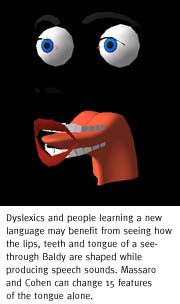Speech: A Sight to Behold
Dyslexia
Most people think of dyslexia as a condition where someone sees letters in
words backwards. Actually, dyslexics are just as likely to add, delete,
or substitute letters in words. They may see "stream" as "steam," or
"get" instead of "got." Whatever their particular difficulties, dyslexics
are unaware they see words incorrectly until told otherwise.
Dyslexics can also have trouble hearing and speaking language, which some
researchers believe is the root cause of their condition. Pat Lindamood,
a speech language pathologist, discovered the importance of spoken
language for dyslexics in the mid-60's. Lindamood found she could help
them read and write better by teaching them how to produce certain speech
sounds.
Dyslexics who undergo this training, called the Lindamood program, will do
things such as feeling their throats while saying certain sounds to make
sure they produce the right vocal cord vibrations for that sound. They
also work with mirrors to see how the tongue and vocal cords come into
play during speech. An instructor corrects them as they practice
improving their speech.
Phyllis Lindamood, Pat's daughter and a co-owner of Lindamood Bell
Processes in San Luis Obispo, California, says the Lindamood program can
improve dyslexics hearing, writing, and speaking abilities. She says some
have overcome their language difficulties completely with intensive
training.
Computers also are playing a role in training dyslexics about spoken
language. Lindamood Bell Processes uses computers to help teach them to
speak better. And a computer game developed by Paula Tallal of Rutgers
University and Michael Merzenich at the University of California, San
Francisco, has allowed dyslexic children to improve at distinguishing
between speech sounds. A New York Times article by Sandra Blakeslee
described the work of Tallal and Merzenich, in which children hear
synthetic auditory speech that has been altered to make individual speech
sounds last longer and sound louder than normal. As the children improve
at distinguishing between the sounds, the sounds are sped up. The
scientists found dyslexic children who worked with the game for one month
jumped two grade levels in their ability to recognize speech.
 Massaro's talking head may one day be an added feature in the computer
arsenals of those teaching language skills to dyslexics. While other
computer programs help dyslexics ferret out differences between the sounds
of a language, Baldy can also give dyslexics the visual information to
improve their own speech. The ability of Baldy to be see through,
revealing his tongue movements during speech, should prove especially
useful.
Massaro's talking head may one day be an added feature in the computer
arsenals of those teaching language skills to dyslexics. While other
computer programs help dyslexics ferret out differences between the sounds
of a language, Baldy can also give dyslexics the visual information to
improve their own speech. The ability of Baldy to be see through,
revealing his tongue movements during speech, should prove especially
useful.
 Massaro's talking head may one day be an added feature in the computer
arsenals of those teaching language skills to dyslexics. While other
computer programs help dyslexics ferret out differences between the sounds
of a language, Baldy can also give dyslexics the visual information to
improve their own speech. The ability of Baldy to be see through,
revealing his tongue movements during speech, should prove especially
useful.
Massaro's talking head may one day be an added feature in the computer
arsenals of those teaching language skills to dyslexics. While other
computer programs help dyslexics ferret out differences between the sounds
of a language, Baldy can also give dyslexics the visual information to
improve their own speech. The ability of Baldy to be see through,
revealing his tongue movements during speech, should prove especially
useful.